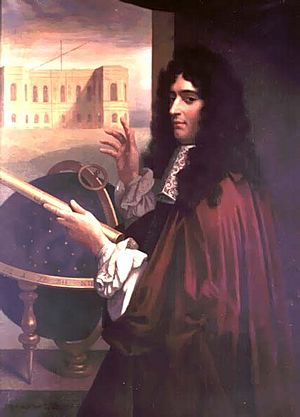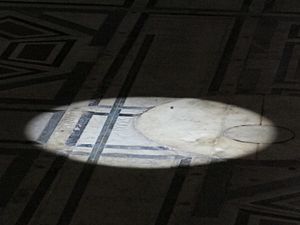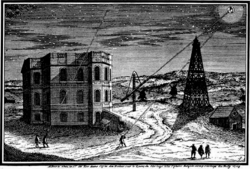Giovanni Domenico Cassini facts for kids
Quick facts for kids
Giovanni Domenico Cassini
|
|
|---|---|
 |
|
| Born | 8 June 1625 Perinaldo, Republic of Genova
|
| Died | 14 September 1712 (aged 87) Paris, France
|
| Nationality | Italian, French |
| Alma mater | The Jesuit College at Genoa |
| Known for | Cassini Division Cassini identity Cassini's laws Cassini oval First to observe the division in the rings of Saturn |
| Children | Jacques Cassini |
| Scientific career | |
| Fields | Mathematics, astrology astronomy, engineering |
| Institutions | University of Bologna |
Giovanni Domenico Cassini (born June 8, 1625 – died September 14, 1712) was a famous Italian and later French scientist. He was a skilled mathematician, astronomer, and engineer. Cassini was born in a small town called Perinaldo, which was then part of the Savoyard state.
He is best known for his amazing discoveries in space. He found four new moons orbiting the planet Saturn. He also noticed a gap in Saturn's rings, which is now called the Cassini Division in his honor. Cassini was also the first in his family to start making a detailed map of France.
The Cassini space probe, launched in 1997, was named after him. This probe was the fourth spacecraft to visit Saturn and the first to orbit it.
Contents
Life Story
Giovanni Domenico Cassini's parents were Jacopo Cassini and Giulia Crovesi. His journey as a scientist began in Italy.
Early Career in Italy
In 1648, Cassini started working at an observatory near Bologna, Italy. He worked with Marquis Cornelio Malvasia, who was an amateur astronomer. During this time, Cassini learned a lot from other scientists like Giovanni Battista Riccioli.
By 1650, he became the main professor of astronomy at the University of Bologna. While there, he studied a comet that appeared in 1652. He also helped the city of Bologna as an engineer, working on water systems and fortifications.

Cassini also helped improve a special sundial at the San Petronio Basilica in Bologna. He moved the tiny hole (called a pinhole gnomon) that projected the Sun's image onto the floor. This allowed him to measure the Sun's image more accurately. He saw that the Sun's size changed throughout the year. This change supported Johannes Kepler's idea that Earth orbits the Sun in an oval shape, not a perfect circle.
Cassini worked in Bologna until 1669. Then, a French minister named Colbert invited him to Paris to help build a new observatory.
Moving to France
Cassini became very famous for figuring out how fast Jupiter and Mars spin. In 1669, he moved to France with the Pope's permission. He helped set up the Paris Observatory, which opened in 1671. He became the director of this observatory and stayed there for the rest of his life.
For over 40 years, Cassini worked for King Louis XIV of France. He focused mostly on astronomy, even though he had studied astrology when he was younger. Cassini became a French citizen in 1673. He married Geneviève de Laistre and had two sons. His younger son, Jacques Cassini, also became a famous astronomer.
Cassini used his skills to measure the size of France more accurately than ever before. He found that France was smaller than people thought! The king even joked that Cassini had taken more land from him than he had won in all his wars.
Cassini became blind in 1711 and passed away in Paris in 1712 at the age of 87.
Astronomical Discoveries
Cassini made many important discoveries about planets and moons:
- He observed markings on Mars and figured out how fast it spins.
- He also determined the rotation period of Jupiter.
- He discovered four of Saturn's moons: Iapetus and Rhea in 1671-1672, and Tethys and Dione in 1684. He called them Sidera Lodoicea (the stars of Louis).
- He noticed that Iapetus changed brightness. He correctly guessed this was because one side of the moon was darker than the other. This dark area is now called Cassini Regio.
- In 1675, he discovered the Cassini Division, a gap in Saturn's rings.
- He is also credited with discovering the Great Red Spot on Jupiter around 1665, along with Robert Hooke.
- Around 1690, Cassini was the first to see that different parts of Jupiter's atmosphere spin at different speeds.
In 1672, Cassini worked with his colleague Jean Richer. Richer went to French Guiana, while Cassini stayed in Paris. They both observed Mars at the same time. By comparing their observations, they could calculate Mars's distance from Earth. This was the first time anyone had estimated the true size of our Solar System!
Cassini also helped measure longitude (how far east or west a place is) using Galileo's idea. This involved watching the eclipses of Jupiter's moons as a kind of cosmic clock.
In 1683, Cassini correctly explained the zodiacal light. This is a faint glow in the sky that looks like a triangle of light. It's caused by sunlight reflecting off tiny dust particles in space.
Cassini also helped introduce Indian astronomy to Europe. He studied an old manuscript from Siam (now Thailand) that described Indian ways of calculating the movements of the Sun and Moon.
From Astrology to Astronomy
When Cassini was young, he was very interested in astrology, which is the belief that stars and planets affect human lives. His knowledge of astrology even helped him get his first job as an astronomer. However, as he grew older and the Scientific Revolution progressed, he focused almost entirely on astronomy, which is the scientific study of space. He eventually moved away from astrology.
Engineering Projects
Cassini was also a talented engineer.
- In 1653, he designed and built a very accurate meridian line in Bologna. This was a complex project, and its success made him famous for his engineering skills.
- He also worked for the Pope, helping with fortifications and managing the Po River to prevent floods. He even wrote reports on how to stop the river from overflowing.
- In the 1670s, Cassini started a huge project: creating a detailed topographic map of France. He used a method called triangulation to measure distances. His son, Jacques Cassini, and grandson, César-François Cassini de Thury, continued this work. The map, known as the Carte de Cassini, was finished in the late 1700s. It was the first topographic map of an entire country.
Works
- (in la) Specimen observationum Bononiensium. Bologna: eredi Evangelista Dozza (1.). 1656. https://gutenberg.beic.it/webclient/DeliveryManager?pid=87221.
- (in la) Martis circa axem proprium revolubilis observationes Bononiae habitae. Bologna: eredi Evangelista Dozza (1.). 1666. https://gutenberg.beic.it/webclient/DeliveryManager?pid=1252522.
- (in it) Spina celeste meteora osservata in Bologna il mese di marzo 1668. Bologna: Emilio Maria Manolessi & fratelli. 1668. https://gutenberg.beic.it/webclient/DeliveryManager?pid=1251926.
- (in fr) Observations astronomiques faites en divers endroits du royaume, pendant l'année 1672. https://gutenberg.beic.it/webclient/DeliveryManager?pid=4667136.
- (in fr) Abregé des observations et des reflections sur la comete qui a paru au mois de Decembre 1680, et aux mois de Ianvier, Fevrier et Mars de cette annee 1681. Paris: Estienne Michallet. 1681. https://gutenberg.beic.it/webclient/DeliveryManager?pid=1251645.
- Cassini, Giovanni Domenico (1682). Raccolta di varie scritture, e notitie concernenti l'interesse della remotione del Reno dalle Valli fatta in Bologna l'anno 1682. (In Bologna): [s.n.]. https://gutenberg.beic.it/webclient/DeliveryManager?pid=1285500.
- (in fr) Elemens de l'astronomie. Paris: Imprimerie Royale. 1684. https://gutenberg.beic.it/webclient/DeliveryManager?pid=4667138.
- (in fr) Découverte de la lumiere celeste qui paroist dans le zodiaque. Paris: Imprimerie Royale. 1685. https://gutenberg.beic.it/webclient/DeliveryManager?pid=4667140.
- (in fr) Régles de l'astronomie indienne pour calculer les mouvemens du soleil et de la lune. Paris: Sébastien Mabre-Cramoisy, veuve. 1689. https://gutenberg.beic.it/webclient/DeliveryManager?pid=4667142.
- (in fr) De l'origine et du progres de l'astronomie et de son usage dans la geographie et dans la navigation. 1. Paris: Imprimerie Royale. 1693. https://gutenberg.beic.it/webclient/DeliveryManager?pid=4667130.
- (in fr) Hypotheses et les tables des satellites de Jupiter, reformeés sur de nouvelles observations. Paris: Jean Anisson. 1693. https://gutenberg.beic.it/webclient/DeliveryManager?pid=4667144.
- (in it) Meridiana del tempio di S. Petronio tirata e preparata per le osservazioni astronomiche l'anno 1655. Bologna: eredi Vittorio Benacci. 1695. https://gutenberg.beic.it/webclient/DeliveryManager?pid=1251458.
- (in fr) Description et usage du planisphere céleste. https://gutenberg.beic.it/webclient/DeliveryManager?pid=1449900.
- Cassini's works digitalized and available on the digital library of Paris Observatory
See also
 In Spanish: Giovanni Cassini para niños
In Spanish: Giovanni Cassini para niños
- 24101 Cassini, an asteroid
- Aerial telescope – large telescopes used by Cassini
- Cassini (lunar crater)
- Cassini (Martian crater)
- Cassini Division in Saturn's rings
- Cassini oval
- Cassini Regio, dark area on Iapetus
- Cassini–Huygens Mission to Saturn
- Cassini's identity for Fibonacci numbers
- Cassini's laws
- History of the metre
- Neith (hypothetical moon)
- Seconds pendulum


